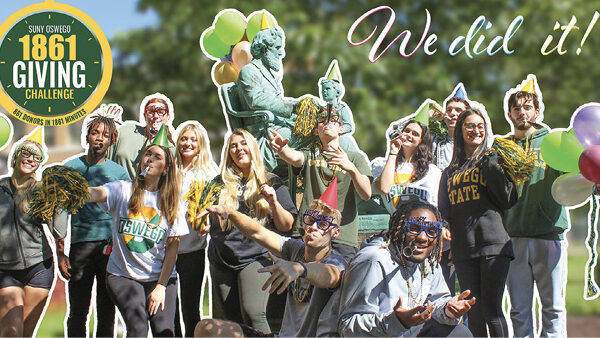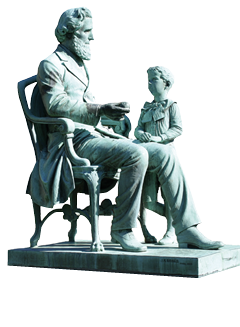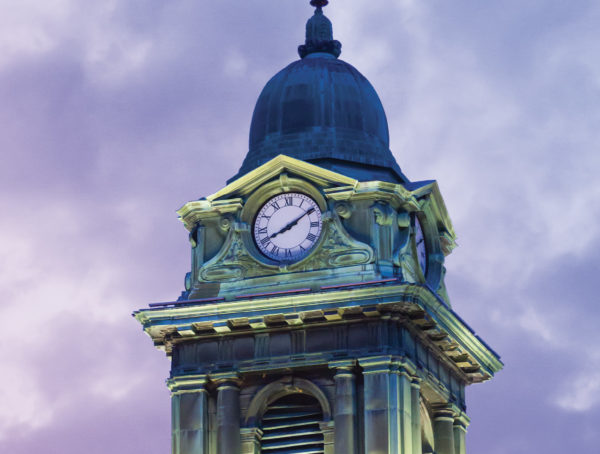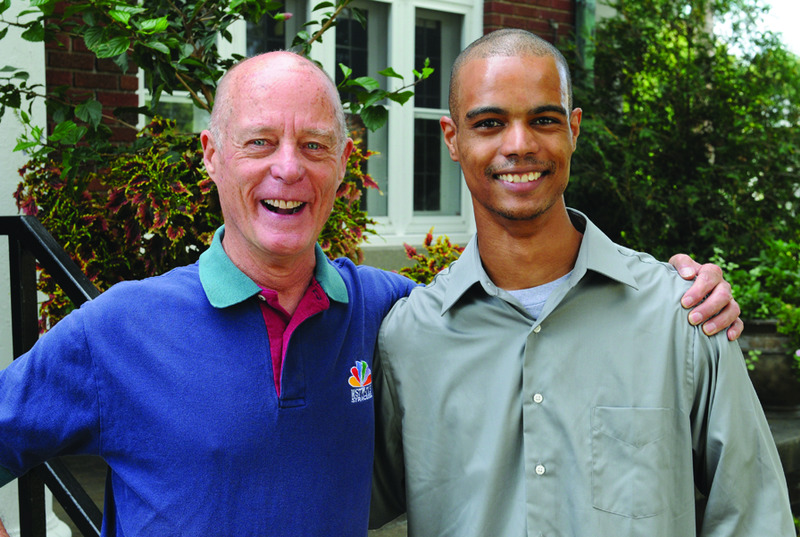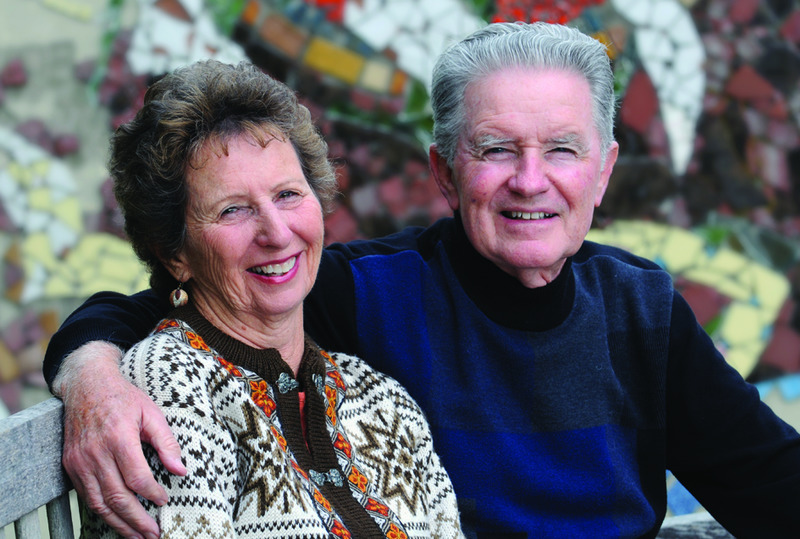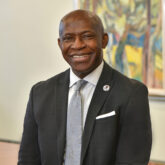Oswego Founder Edward Austin Sheldon left behind a window into his life — his autobiography. In honor of Oswego’s Sesquicentennial celebration, we excerpt here some snippets of Sheldon’s stories. Earliest Recollections
 They say I was born October 4, 1823, and from this date I reckon my years. It seemed to me a long time from one to twenty-one. As a boy I felt that I could never live to be twenty-one. Even now as I look back over my existence, it sometimes seems to me that I have lived forever.
They say I was born October 4, 1823, and from this date I reckon my years. It seemed to me a long time from one to twenty-one. As a boy I felt that I could never live to be twenty-one. Even now as I look back over my existence, it sometimes seems to me that I have lived forever.
My School Life
School life to me was one continuous holiday. To study was out of the question. I did not know what it was to study. I have no remembrance of having studied a moment in two years, unless it might be called studying to memorize lists of (to me) utterly meaningless words. …
The boy literally hated study. With tears in his eyes, over and over again, he pleaded with his father to allow him to stay at home and work. The father’s answer always was, “Edward, when you are older, you will always be sorry that you neglected your school.’’ The answer of the heart, though not expressed in words, was, “I know better.” I am not prepared to say that I have much feeling of regret for the loss of anything that possibly could be gotten out of those schools. I regard them as practically worthless. I really think it would have been better if my father had granted my request and kept me at home. I am inclined to the opinion that I got out of them all that was possible, and all that other boys did realize. The chief benefit one received came from contact. I often think that children get more of intellectual and spiritual growth from their plays and consequent contact than from their books and instruction. This part of my early training was abundant and efficient.
Preparing for College
At the turning point between youth and young manhood, a circumstance occurred that changed the plans of my whole life, and turned all my ambitions into an entirely new channel. When I was seventeen, Mr. Charles Huntington, just out of college, came to Perry Center and opened a private school. Into this school were gathered most of the young men and women of the town in the immediate vicinity. Here for the first time I became interested in books, and began to study.
Up to this time I had detested both books and the school, and as a consequence I had no intellectual equipment. My father had always urged me to go to school, and I had as persistently urged to be allowed to stay at home and work on the farm. All at once my father’s and my ideas were reversed. I had now come to an age when I could make myself very useful on the farm, and my father desired my services, and wanted to make a farmer of me … So now my father wanted me to stay at home on the farm just when I wanted to go to school.
College Life
During the winter months, I often spent an hour sawing wood out of doors, for which the college paid me fifty cents a cord. The pay was small, but it was something to a poor boy, and gave me healthful exercise, which paid better.
I felt to be a great compliment. This society was composed of the most scholarly and best elements in the college, and I did not hesitate to accept the honor proffered me. … my association with the members of this fraternity was of great value to me. I would not have lost the good that came to me through the close contact with the young men who composed this society, for any consideration. I value it above all other good I got out of my college life. They were strong men, possessed of high ideals and noble aspirations, and they brought into my life that which I never could get from the study of books. Among them were men who have taken high positions in the civil, religious, and literary world. I have always been proud of and thankful for their companionship.
Early in my college course I discovered something about myself that, curiously enough, I had never known before. I noticed that I could not see work on the board that other members of my class seemed to see readily. This led me to the suspicion that I was near-sighted. When convinced that this was true, I lost no time in bringing to my aid a pair of glasses. …On returning to College Hill, I went to the fourth story of one of the college buildings, to look out upon the world which I had never really seen before. …From that time to this, I was never without my glasses, except that at first when returning to my Perry home, I would doff them and put them in my pocket to avoid possible remarks from my good country friends.
The scholastic work in college was almost exclusively of a bookish character and confined very largely to the languages and mathematics. Very little was done in science, and that little was in Chemistry. It was pretty generally thought by the students that if we had our pictures taken by the professor of this department, paying for the same the sum of three dollars, we should be safe from rejection in this subject. For me this seemed the easiest and surest way out, and I had my picture taken. It was a daguerreotype, the only mode of taking pictures at that day, and it was then quite new. This picture is well preserved to this day. How much this transaction had to do with my passing out of Chemistry, no one will ever know, but of one thing I am certain, I got “out” of the subject without knowing anything about it; and my case was not different from that of most students.

Abandonment of College Course
… During my Sophomore year, while on a visit to Uncle Asa Austin’s at McGrawville, I had an attack of pleurisy, brought on by inordinate laughing. Instead of returning to college, as was my expectation, I was obliged to hasten home, where I was confined some months by this somewhat serious attack.
Early in the fall, Mr. J. W. P. Allen, a nurseryman from Oswego, came to Newburgh to purchase nursery stock, and he besought me to go to Oswego and take an interest with him in the nursery business which he had already established. … Abandoning my college and law-school plans, I went to Oswego in the fall of 1847 to enter upon my new enterprise.
[Eventually the business failed, and Sheldon was left without work or a place at school.]
The Ragged School: 1848-1849
During this period of suspense, it came into my mind to investigate the condition of the poorer classes in the city of Oswego. I accordingly invested five cents in a small blank book that I could carry in my pocket, decided upon the statistics I could gather, and began my rounds among the poorer tenements in the outskirts of the city. Among the items that interested me particularly was the educational status of the poor. Greatly to my surprise, I found fifteen hundred persons who could neither read nor write. As a country boy I had hardly known of such a person, and my astonishment may be well understood on finding such a degree of gross ignorance. To me it seemed like being in the midst of heathendom.
[Sheldon took his idea for a school to teach these children to the prominent citizens of the city.]
This resulted in the call for a meeting of a few prominent, benevolent, active citizens to consider plans of operation. The first meeting was held Tuesday, October 31, 1848. The result was the organization, on November 28, of the “Orphan and Free School Association.”
Extracts from a Letter to His Sister
Oswego, Nov. 23, 1848.
Thus it was settled that I was to take charge of the new “ragged school,” as it was dubbed. Nothing could ever have been farther from my thoughts than the idea of teaching school; nothing for which I considered myself so poorly adapted. …
Thus I found myself in the autumn of 1848 with one hundred twenty to one hundred thirty wild Irish and French boys and girls, in the basement of what was called the “Tabernacle,” a building that stood on West Second Street, near Bridge Street, on the site of the present engine house.
Many of these children had never been inside a schoolroom, and knew no better how to behave as pupils than I did as teacher. This was a strange school, with a no less strange teacher. None such had ever been assembled in Oswego.
One thing is surely true: if any principles of pedagogy were applied in this school, they were either intuitive or accidental. I had never read any theories of school teaching, and certainly had none of my own at the outset; at least, all my work was haphazard. About all I knew was that these children were poor, neglected, and ignorant, and needed sympathy and help; and these I certainly could give them. Of this I am also sure, I got their confidence and love. It was a usual sight on my way to school to have a large number of these poor children hanging on to the ends of my fingers and coat-tails, greatly to the amusement of the lookers-on.
MORE: Alumni, students to stage Sheldon stories
Marriage: 1849
In the spring of 1849, on the 16th of May, occurred the most important event of my life — that which had more to do with my success, my usefulness and happiness, than all other events combined. …This partner of my life did more to mold my character and make me what I have been and am, than all the other circumstances of my life.
[From 1851 to 1853, Sheldon held the position of Superintendent of Schools in Syracuse.]
Meantime, in Oswego, … the effort to secure free schools was bound to go on.
… The first board of education was organized May 11, 1853, and quite unsolicited by me and greatly to my surprise, I was elected clerk or secretary as the office was termed, the salary to be eight hundred dollars, with prospect of an advance.
I had formed a strong affection for Oswego, and some of its citizens in particular, a number of whom were in the Board. In Oswego I would have the advantage of organizing a system from the start, in accordance with my own views. … I resigned my position in Syracuse, and entered at once upon what proved to be my life-work in Oswego.
Notwithstanding all perfection of organization, and I think it would be very difficult to find anything more complete, there was something to give life, spirit I may say, soul to the school system. As a machine it was perfect, but it lacked vitality … We wanted something that would wake up the pupils, set them to thinking, observing, reasoning.
It must be more objective. But there were no facilities for carrying on such work. For this purpose we wanted collections of objects of all sorts, illustrations of every kind. We wanted more reading matter, and that which was better adapted to the ages of the children; we wanted charts of color and form, natural history, pictures, objects for teaching number, etc.
This was in September, 1859. A month later … I went on a tour of inspection to the schools of Toronto, Ontario. To my astonishment I found here very many of the facilities I had been wishing for. Here I found, greatly to my surprise, what I did not know existed anywhere — collections of objects, pictures, charts of colors, form, reading charts, books for teachers, giving full directions as to the use of this material.
I invested three hundred dollars in these pictures, objects and books, and hastened home a happier man than I went. I was not long in making out a new course of study for my Primary schools, introducing a complete course of objective work, employing the material brought from Toronto.
A new era had come to our public schools. Important changes were being inaugurated that were destined to revolutionize methods of teaching not only in Oswego, but in the whole country.
At one time our little home came very near being buried in the snow. It was in the winter of 1853. It was late one Saturday night, after my duties as librarian were over and I had closed my office, that I started for home in a heavy snowstorm …
This proved to be the severest snowstorm that has been known in Oswego since that day. The storm continued for three days with unabated fury, filling the streets with snow and obstructing all travel. Practically all business was suspended. The schools were closed. Neither teachers nor pupils could get to them. I did not, in fact, could not, leave my house for three days. I got out of the chamber window into a plum tree that stood near, and shoveled off the snow to prevent the accumulating weight of it from breaking the tree to pieces. At the end of three days I went out the back door, and coming around to the front gate dug a tunnel to the front door, and through this tunnel we passed out and in for many days. At this time I saw some of the smaller houses literally buried in the snow, with hardly more than a chimney to show the existence of a house.
… Such snowstorms, however, were not frequent. They were the exception, and have become more and more rare since that day.

Establishment of the Teacher Training School
I proposed to the board that we should establish a city training school for the training of primary teachers. … giving them one year of strictly professional training. One half of the time was to be given to a discussion of educational principles and their application to teaching the elementary branches, and the other half to teaching under criticism.
The next question was, who should be the teacher of this Oswego Primary Teachers’ Training School, as I decided to call it. … No such school existed in America, and the methods of instruction were quite as new as the design of the school. In this dilemma I decided to go abroad for a teacher. In London, England, was the Home and Colonial Training Institution. Although organized on a different plan from my own, it was training teachers on Pestalozzian principles. … Miss Margaret E. M. Jones, who had been a teacher with them for eighteen years, had consented to come at a salary of one thousand dollars and all living expenses. This seemed to our board a very large sum to pay, and they hesitated. But I said to them: “If you will appoint this woman, I will guarantee to the board that it shall not cost the city one cent,” and on the strength of this they offered the resolution, being careful to put into it my guarantee that “it should not cost the city one cent.”
I was careful to keep my word with them, and showed them at the end of the year that Miss Jones had not only been no expense to them, but had actually put into the treasury three hundred dollars over and above expenses. It was done in this way. In the first place I charged a tuition of fifty dollars to all persons not residents of Oswego who joined the class. In the second place I persuaded a number of the more progressive teachers to contribute one-half of their salary for the year, in view of the benefit that would come to them from the instructions of the “London Training Teacher.” In the third place, by converting one of the schools into a school of practice, I saved the salary of one teacher. In this way I made the training school a help rather than a hindrance to the finances of the board.
This movement was going on in the spring of 1861, and in May the school was opened with Miss Jones at the head.
In the regular training class were nine pupils. Miss Jones met her class for special instruction and direction in a small cloakroom off from the school of practice. The accommodations were very limited, and so was the class.
In addition to the regular school of practice, we had one model school, used exclusively as a school of observation, and one school taught successively by the members of the training class. These schools were in the Academy building. This was the first Teachers’ Training School ever organized in America. They are now to be found in nearly every populous city, but I have yet to learn that any radical improvement has been made on the “Oswego Training School.”
It was at this time that the question arose as to who should be principal of this training school when Miss Jones should leave. … When Miss Jones heard of my proposition to make Mr. Weller principal, she went to the members of the board and stoutly protested, insisting that Mr. Sheldon should be made principal. … I was thus made Miss Jones’ successor-a position to which I did not aspire, and for which I seemed to myself to have no suitable qualifications.
The new movement was quite revolutionary in its character. The ordinary processes of education were reversed. From the old methods — of words first and ideas afterwards — to the new — ideas first, words afterwards — the change in the character of school work was a marked one.

Reputation and Influence of the School
Many representative educators from different parts of the country, and teachers from every grade were from time to time visitors to the training school and the public schools. Many of the most competent graduates of the school had been invited to different cities to organize city training schools on the plan of the Oswego Training School, and to State Normal schools to organize training departments in connection with schools of practice.
In 1866-67 six additional state normal and training schools were established in New York State, all on the general plan of the Oswego school, only that the courses of study were considerably enlarged.
The Oswego school was organized on a different plan from any other normal school in the country, in that it had a full year of professional work with a large school of practice sufficient to give an opportunity for all the members of the graduating class to teach at least five months under criticism.
A distinguishing feature of our school from the beginning has lain in our constant endeavor to emphasize the purely professional side of the training, and to exclude, as far as practicable, the academic lines of work.
We have also a manual training course which is optional … We have a shop finely equipped for this work, which is under the supervision and direction of Mr. Piez, who is remarkably competent.
The Death of Sheldon
He spoke of dying as though it were an every-day occurrence, and passed peacefully away at 8:30 a.m. (August 26th, 1897).
A Memorial Exercise, to which all the Alumni and others were invited, was held at the school, October 21, 1897.
The Alumni further planned raising a fund to establish a Sheldon scholarship in pedagogy at Cornell University, which through the generosity of an Alumna has been completed.
The most prominent memorial that has been erected to the memory of Dr. Sheldon, consists in the bronze statue that stands in the Capitol at Albany, which was unveiled on January 11th, 1900.
This statue was the contribution of the school-children and educators of New York State…
3,007 schools, numbering about 200,000 children, responded to the appeal. From their penny contributions, and the larger ones of educators, about $3,500 was raised, of which $3,000 was paid to the sculptor, the remainder being disbursed for incidental expenses.
The statue was executed by John Francis Brines … Governor Roosevelt unveiled the statue.
You might also like
More from Fall/Winter 2011
Upcoming Events
Jan. 1 Nominations due for alumni awards* Jan. 1 Nominations due for Athletic Hall of Fame* Jan. 4 New York City Career Connections* March …
Young Veteran Aims to Pass on Help He Received
He started his adult life homeless, and entered the Army to get a roof over his head. But when U.S. …
Former Professors Endow Scholarships in Music, Wellness
During their long careers at SUNY Oswego, Hugh and Grace Mowatt Burritt helped thousands of students reach their full potential. …







